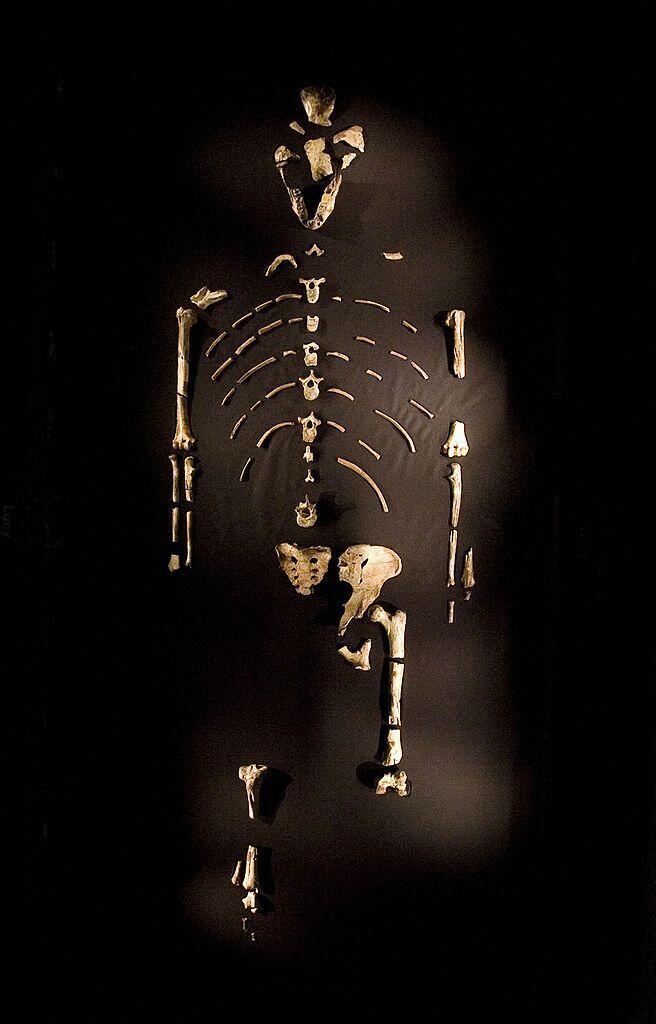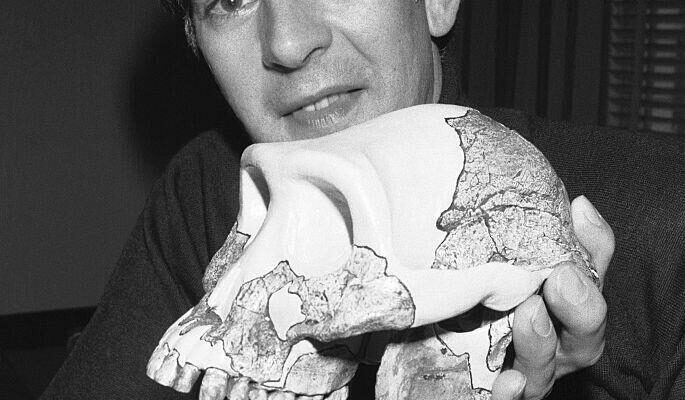Lucy’s discovery took place in the Afar region of northeastern Ethiopia. Donald Johanson, an American anthropologist, and the student who accompanied him, Tom Gray, spotted a piece of elbow, likely to have belonged to a hominid. A few days later, the analysis of these prehuman remains was clear: it was a woman. She lived 3.2 million years BCE.
7 mins
Teeth, vertebrae, fragments of pelvis, femur, tibia, but also arm bones such as the humerus, radius and ulna: these are indeed among the abundance of bones discovered during an expedition co-led by Donald Johansson, Yves Coppens and Maurice Taieb that lies the exceptional nature of the discovery. All belong to a single fossil recorded under the scientific number AL 288-1, for the 288th locality explored on the right bank of the Awash River, Ethiopia.
They are very quickly collected, assembled and thanks to the symmetry of the skeleton, a fairly precise silhouette emerges. The fragments of the pelvis allow scientists to establish that it is a female subject. It is renamed Lucy, a nod to the Beatles song “ Lucy In The Sky With Diamonds » in the ears of all the members of the scientific expedition.
Lucy is just over one meter tall. Its head is the size of a grapefruit, a third smaller than that of a human. She has fairly large teeth and ate mainly fruits and tubers. She was around twenty years old when she died. The causes of his death at the water’s edge are not clearly determined, some researchers suggest a possible fall from a tree due to compression fractures of the shoulder and arms, others a drowning in the Awash River .
The anatomical study of her upper and lower limbs as well as the footprints found in volcanic ash in 1978 in Laetoli, Tanzania, will however make it possible to prove two things: Lucy walked. It was therefore bipedal. And Lucy climbed trees, both crucial elements in understanding human evolution. A recent study from the University of Cambridge published in the journal Royal Society Open Science has, for the first time, digitally reconstructed Lucy’s missing soft tissue, confirming that while Lucy had been able to stand up straight, she was also able to use her limbs in a repertoire of movements similar to chimpanzees and bonobos.
Also listenWhat have we learned from Lucy 50 years after her discovery in Ethiopia?
Lucy, the most famous representative of Australopithecus afarensis
In 1978, four years after its discovery, Lucy, or Dinqnesh for the Ethiopians, was classified in the category of Australopithecus afarensis by Donald Johanson, Tim White, and Yves Coppens, a name in homage to the Afar region where many specimens were found. Australopithecus afarensis lived in the Pliocene, a crucial geological epoch for the evolution of hominids due to significant climatic changes and the transformation of fauna and flora. The diversity of terrain certainly explains this mixed locomotion of the species, both with bipedal walking in open environments such as savannah or arboreal abilities in wooded areas. “ We counted and identified 50,000 grains and the reconstructed landscape was made of swamps, with reeds, rushes, perhaps grasses, but also forest areas with large trees that we could climb. “, tell Raymonde Bonnefille, geologist having participated in the Franco-American scientific expedition in 1974 in Afar, guest of Caroline Lachowsky on RFI, who continues to question the extreme adaptability of this species which has persisted for eight hundred thousand years.
If the enthusiasm of the scientific community is immediate, the journal National Geographic helps make Lucy a celebrity. Just like the discoverers, Yves Coppens in the lead, who will put their talents as popularizers at the service of paleontology. Very quickly, it was the subject of numerous representations in school textbooks and museums and inspired many artists. In Ethiopia, the unearthing of Lucy’s remains is a matter of national pride. She is nicknamed “the grandmother of humanity”, that is to say the direct ancestor of the human race, Homo (capable of producing tools with her hands and endowed with a larger brain). A linear diagram always defended by Donald Johanson for whom Australopithecus afarensis “ remains our most probable ancestor and constitutes one of the most important species in the history of human evolution “.
However, subsequent scientific expeditions have rather supported the thesis defended by Yves Coppens according to which Lucy is not our grandmother, but our great-aunt. The species Australopithecus afarensis would constitute a distinct branch which does not lead directly to Homo sapiens. For the famous French paleonthologist who died in June 2022human evolution took place in a bouquet with genetic drifts depending on the populations of the same species, far from the image long conveyed by the popularization fresco drawn by Rudolph Zallinger (1919-1995) of an animal on all fours who stands up to become a man.

Africa, central point of research on the origin of humanity
If, at the time, Lucy was the oldest and most complete Australopithecine with 40% of her skeleton found, other more recent discoveries will help establish that there was indeed a coexistence of different species of australopithecines in the period from 3 to 4 million years before our era in southern Africa, but also in South Africa. In 1994, South African paleoanthropologist Ronald Clarke identified four bones from a hominid left foot in Silberberg Cave, near Johannesburg, South Africa. The exceptional state of conservation of the fossil, nicknamed “Little Foot”, encouraged him to continue his research. A careful excavation consisting of removing bones from the sedimentary rock resulted in the extraction of a skeleton, that of a woman, almost 97% complete. The age of Little Foot is set at 3.67 million years old and belongs to the species Autralopithecus prometheus. Unlike Lucy, she has a longer, flatter face.
In March 2011, another cousin was discovered by Yohannes Haile-Selassie’s team in Ethiopia. It is 3.4 million years old and named Australopithecus deyiremeda. In 2016, on the Woranso-Mille site, 55 km from where Lucy was discovered, a new fossil, called MRD, is added to humanity’s photo album. It belongs to one of the very first Australopithecines, called Australopithecus anamensis. For the Ethiopian paleoanthropologist, one thing is certain, “ there is now indisputable proof that several species of hominids lived at the same time in East Africa ”, and in great geographical proximity.
Another certainty: whether in Africa, France or the United States, everyone knows Lucy, an eminent member of an international collective history. Exhibited in many museums around the world in the form of replicas, his original bones remain well guarded, in a safe, in his country of origin, Ethiopia.
Our selection on the subject:
